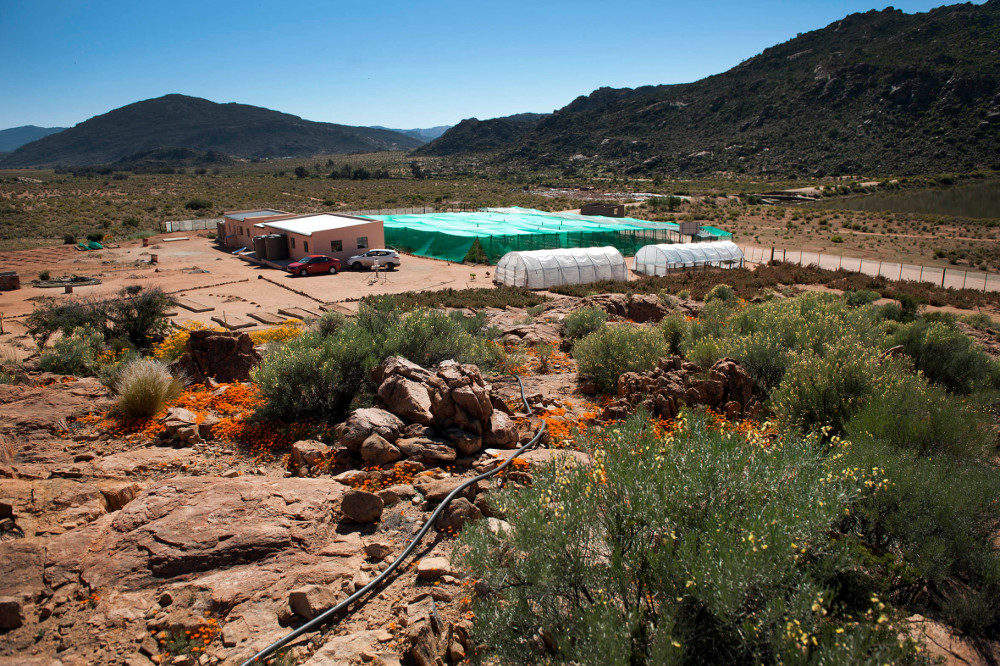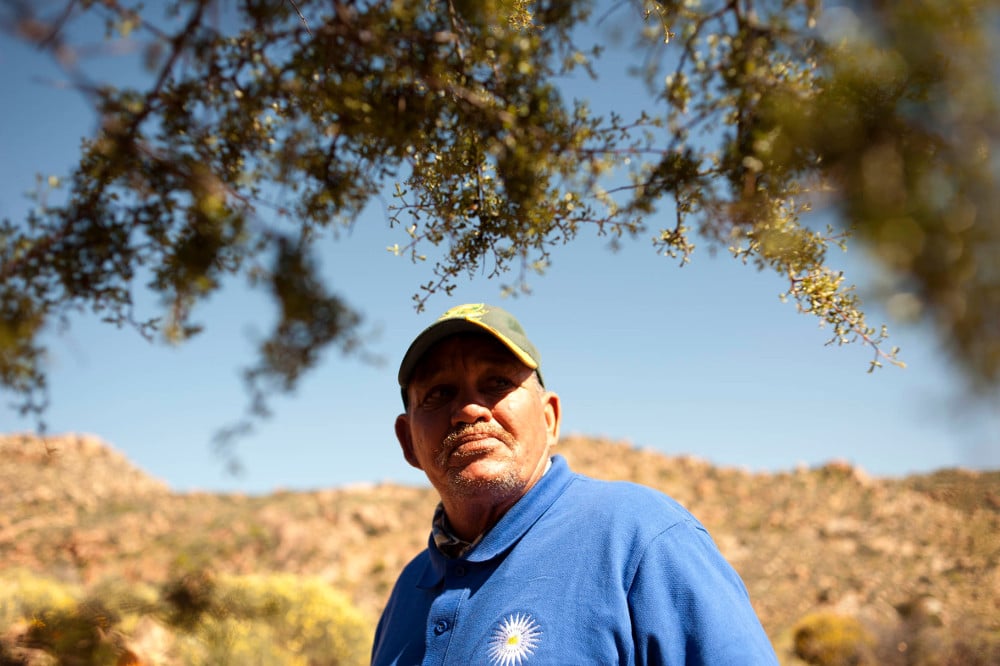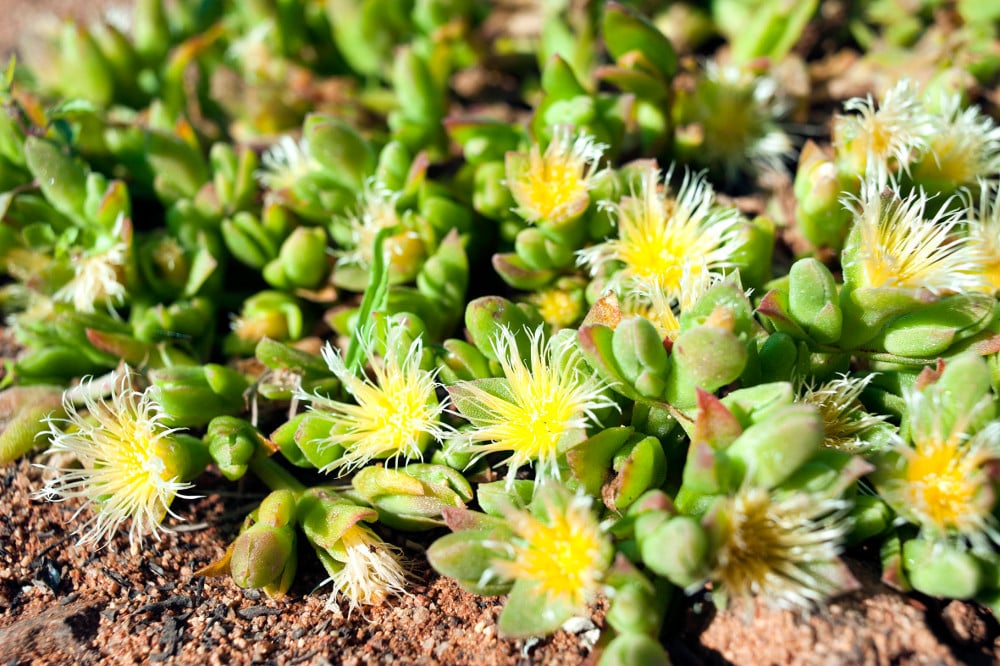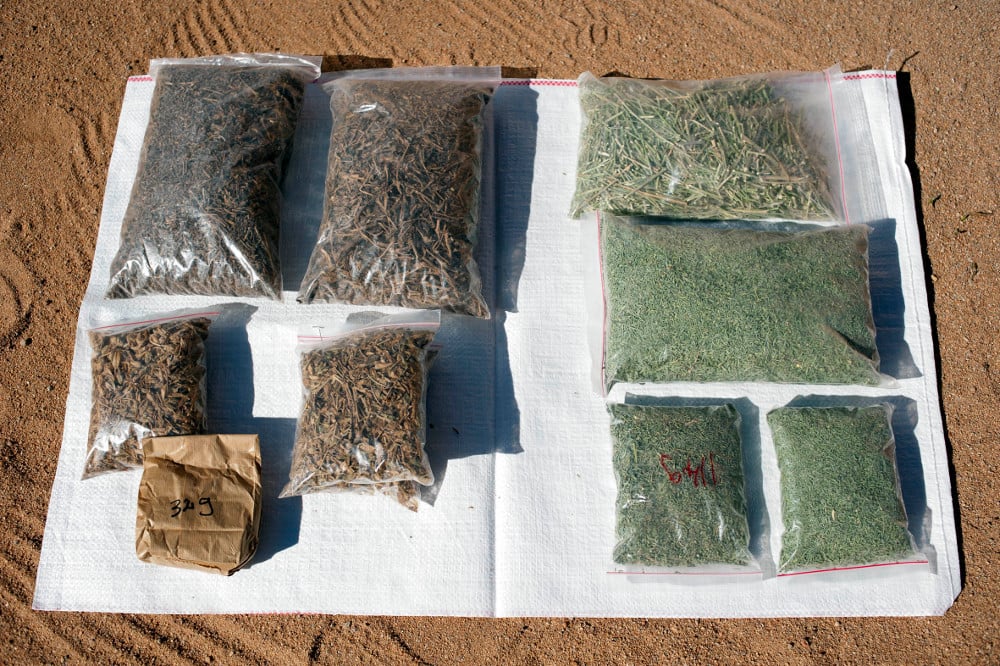Kougoed is a legal alternative to marijuana.
Oom Jap, a Nourivier resident and traditional healer, and I stand in the shadow of one of the new buildings at the Council for Scientific and Industrial Research’s (CSIR) kougoed project in the Northern Cape. Even though we are in the small building’s shade, Oom Jap pulls his faded Springbok cap further down his head to cover his rheumy eyes. He reaches into his pocket and pulls out a bag of Best Brand rolling tobacco, the plastic coating soft from age and use. A pungent earthy aroma comes from the green-brown contents, a mixture of stalks and clumps of dried leaves that is definitely not tobacco.
Sceletium tortuosum, a naturally occurring succulent plant called kougoed or kanna, has been used by the Bushmen and Khoikhoi people for hundreds, possibly thousands, of years, as a drug or medicine. It has gained popularity in the past few decades among weed smokers as an alternative – and legal – high to marijuana. You can even buy it over the internet from numerous suppliers.
I am about to take a pinch of the kougoed from the proffered pouch when Lizande Kellerman, project manager, says loudly: “No, don’t do that now. It will make you sleepy.”
Or, even worse in a professional context, it could make me high.
The sun bakes down on the colour-filled fields of Nourivier in the Northern Cape. It is September and the Namaqualand daisies, a tourist drawcard, are showing off in splashes of orange, pink, white and purple. Just outside the town – which boasts about 300 inhabitants, dirt roads and no cellphone signal – is an initiative that hopes to provide residents with a sustainable source of income, aside from the social grants that are its bread-and-butter and the seasonal tourist money.
The inhabitants of the region, as well as visitors as far back as the 17th century, have long known about kanna and its soporific and intoxicating effects.
Peter Kolbe, the country’s first official astronomer and an avid botanist, is claimed to have said that kanna was “the greatest cheerer of the spirits and the noblest restorative in the world”.
According to Oom Jap, kougoed (chewing stuff) is the panacea for all illness: headaches, depression, a sore stomach, colicky babies. But the world’s focus on this South African plant is as a mood elevator and possibly a candidate for treating depression and addiction.
In this small community where unemployment is the norm rather than the exception, it offers an economic alternative. The idea, Kellerman says, is to mass-produce the S. tortuosum under the large green shade-cloth tunnel that runs in front of the two buildings, used as an office and a processing facility.
Because kougoed consumption is so common in the region, S. tortuosum, which looks like a succulent ground cover with small pincer-like leaves, is endangered and overharvested.
Functional and productive
At the moment, the project employs 12 people. “I want to [initially] keep it as small as possible and make it functional and productive,” Kellerman says. “Then we can expand the project, grow more plants and increase the effects it has on people’s lives …”
“The market is out there [among local communities and internationally], and there’s potential for large-scale production.”
HG&H Pharmaceuticals, among a number of other Sceletium producers in South Africa, proves that is true. Founding director Nigel Gericke, a medical doctor has developed an S. tortuosum extract, called Zembrin.
“We’re selling the product successfully on the US market,” he tells me in Cape Town, where he is based. “We sell the extract, not capsules or tablets.
“At the moment, the market is for everyday people suffering from stress, tension and anxiety,” Gericke says, adding that in the future the company will seek to partner with pharmaceutical companies to investigate its efficacy in treating dementia and early-stage Alzheimer’s.

About 12 local people are employed at the Nourivier project researching Sceletium tortuosum or kougoed. (Photos: David Harrison, M&G)
In 2010, HG&H Pharmaceuticals received South Africa’s first bioprospecting licence, allowing the company to commercialise this indigenous product.
At the licence’s handover, former water and environmental affairs minister Buyelwa Sonjica said the historical lack of framework regarding bioprospecting had “permitted an almost unconstrained access to South Africa’s indigenous biological resources and indigenous knowledge, with biological and genetic resources being harvested, sometimes in destructively excessive quantities, and being exported for research and development at institutions abroad for value addition, and off-shore financial benefit”.
The cautionary tale of unacknowledged use of a South African plant occurs closer to home with Hoodia gordonii, which the Bushmen used as an appetite suppressant.
In 1977, the CSIR isolated what was believed to be the plant’s active weight-loss ingredient – P57, a complex sugar within H. gordonii – and patented it in 1996, unbeknown to the Bushmen. Hoodia hit international headlines when the Bushmen discovered their knowledge had been licenced to a British pharmaceutical development company, Phytopharm, without their consent. In 2010, the commercialisation rights were returned to the CSIR, which brokered a benefit-sharing deal with the Bushmen.
Profit share
Within the first 10 minutes of discussing Sceletium and Zembrin, Gericke introduces their benefit-sharing agreement with the South Africa San Council.
“The profit share is [directly] with the San council because of the indigenous knowledge,” Gericke says. “In turn, the San council shares royalties with two communities, Nourivier and Paulshoek. Our agreement is with the council, not the communities.”
A Nourivier resident says that, for them, the collaboration results in a bursary fund for pupils in the town and in Paulshoek. Neither of the HG&H Pharmaceuticals’ Sceletium farms – and the resulting jobs – are in those communities, something some residents say is a source of contention.
One farm is in Limpopo, the other near Mbombela (Nelspruit), Gericke says. “We’ve grown it outside of its natural environment, in geographically separate areas, because of the unpredictability of the weather.”
Also, “we grow a particular variety, and we didn’t want it to be cross-pollinated”, Gericke says.
S. tortuosum is one of eight species of Sceletium, meaning “skeleton” because of spine-like veins in its dried leaves. It is a member of the Mesembryanthemaceae genus, commonly known as “living stones”, which includes succulents found in the Northern and Western Cape.

Oom Jap is a healer and prepares kougoed in the traditional way.
Within Sceletium, there are specific alkaloids (natural chemical compounds) that give the plants their intoxicating and medicinal effects.
“Our plant [used in Zembrin] was chosen on the profile of the alkaloids,” Gericke says. “For ‘legal highs’, people promote the high mesembrine content, a particular [alkaloid] compound in the plant, which is intoxicating.”
For Zembrin, they selected a plant low in mesembrine and patented the formulation of their extract. In an article in the Journal of Ethnopharmacology in 2008, entitled Sceletium: a review, Gericke and Professor Alvaro Viljoen write: “US Patent 6 288 104 discloses the use of mesembrine and related compounds … as serotonin-uptake inhibitors, and the use of standardised amounts of these compounds in pharmaceutical formulations for use in the management of psychiatric and psychological conditions, including depression, anxiety, drug dependence, bulimia and obsessive compulsive disorder.”
In South Africa, Pretoria-based pharmaceutical company Brunel Laboratoria produces elev8, yellow tablets containing 25mg of Zembrin, which it claims “elevates mood, assists in coping with stress”.
Gericke says that standardised Zembrin allows you to “feel calm when you take it, but at the same time you can focus on your work”.
But an “elevated mood” and “wellness” are difficult to quantify and prove, compared with a product claiming to address a disease. Additionally, complementary medicines are not required to undergo stringent clinical trials to prove efficacy, although there is a push from the department of health to regulate the more than 150 000 complementary medicines on shop shelves.
After a week on elev8, I cannot testify to whether my mood is elevated or my sense of wellness has increased.
HG&H Pharmaceuticals is not the only producer of Sceletium in the country. Richard Davies, executive manager of Verve Dynamics, Somerset West, has a patent pending on one of his Sceletium extracts, Trimesome, named because “there are three mesomes (three of the active compounds specific to the Sceletium plant) and it’s mine”.
The company has been inspected by the United States’s Food and Drug Administration and is registered with CapeNature.
Davies, a self-proclaimed psychoactive enthusiast, says their business initially focused on soaps and candles and “progressed [into] medicinal herbs”. He “stumbled upon Sceletium” after reading about it in a book, he says. But when he first tried the plant it didn’t work.
“You need an alkaloid profile [for the plant to have an effect]. There is literature about what makes Sceletium active: the plant type, the harvesting protocol, the fermentation process,” explains Davies, who taught himself about the chemistry of plants. “So, I got a machine that allows you to isolate individual alkaloids.”
The company sells the active ingredients in Sceletium, which it buys from contract producers around the country and in Namibia, but it has plans to produce and sell its own Sceletium products. “Trimesome is just one of the actives we’ve sold,” Davies says.

The pulped leaves are buried in a bag for eight days and dried in the sun.
The company is interested in eight of the active compounds it has isolated from Sceletium plants, whose effects range from a stimulant to an incapacitant.
“You can blend the actives to get different effects,” Davies explains.
Although Verve Dynamics has not undertaken clinical trials on people, its products are tested by external scientists to ensure their quality.
Its competitor, HG&H Pharmaceuticals, has commissioned studies and undertaken clinical trials, albeit with small sample numbers, to prove the efficacy of Zembrin.
The research, financed by HG&H Pharmaceuticals, focuses on proving that Zembrin is a selective serotonin reuptake inhibitor.
Serotonin, a chemical that is found throughout the human body, is thought to be a vital contributor to feelings of wellness and happiness. By prolonging the availability of serotonin in the neural synapses, these inhibitors increase the levels of serotonin in the central nervous system, promoting feelings of wellbeing – a desired effect for people who suffer from depression or anxiety.
Numerous studies, often by people affiliated with HG&H Pharmaceuticals, claim Zembrin, and specifically the mesembrine alkaloid in it, acts as a selective serotonin re-uptake inhibitor, although this has not been tested on people.
Clinical trials
There have been two clinical trials on people undertaken that include Gericke on the list of authors: one to look at its toxicity with a sample of 37 subjects, with one dropout (it was found to be nontoxic) and one on the electrical activity in the brain.
The study involved a functional magnetic resonance imaging (fMRI) scan for measuring brain activity on 16 people who had taken Zembrin.
Their focus was on the amygdala, a part of the brain linked to memory formation, decision-making and emotional responses that sends messages to the hypothalamus, which is linked to the nervous system. In a paper, published in the journal Neuropsychopharmacology in 2013, the authors write: “We show Zembrin, compared with placebo administration, reduces anxiety-related amygdala reactivity and attenuates amygdala-hypothalamus coupling.”

Kougoed leaves are being tested and packaged in preparation for sale.
Professor Carine Smith, head of the multidisciplinary stress biology research group at Stellenbosch University, undertook a study published in the Journal of Ethnopharmacology, to test whether S. tortuosum reduced stress and anxiety in rats. The rats were given either a placebo, 5mg/kg/day or 20mg/kg/day of their formulation of S. tortuosum extract.
Although Sceletium decreased the production of a stress hormone in rats, detected through an observed reduction in grooming and postmortem tests, there was an increase in IL-1beta (Interleukin-1beta), a protein that may promote inflammation. “This should be investigated in different situations for more clarity; although [this protein] activates many beneficial physiological responses, it may exacerbate some undesirable conditions, such as chronic inflammatory diseases,” Smith says.
There have also been other uncontrolled studies (which did not include patients on placebo treatment to compare the drug’s effects) on stressed cats and dogs with dementia, which found S. tortuosum had a calming effect; the molecular physiological function of mesembrine and the other Sceletium alkaloids has not been determined.
“The exact mechanism of action is still largely unknown. Ideally, we should do controlled studies on all the alkaloids in Sceletium before we can say for certain which alkaloid is responsible for which of the reported effects, both in science and anecdotally,” Smith says.
Preparation
This understanding is complicated by different forms of preparation – tincture, tablet, mouthful or smoked, and whether it has been sun-dried, fermented or its alkaloids extracted.
A tablet containing 25mg of Zembrin, the standard dose in an elev8 tablet, is a different experience to consuming kougoed as Oom Jap does. He has prepared his stash traditionally. The swollen leaves of the S. tortuosum plant are picked and crushed on a rock. The pulp is put in a plastic bag – traditionally an animal bladder – and buried for eight days, after which it is dug up and sun-dried. This process allows the S. tortuosum to ferment, giving it different properties to dried Sceletium.
Smith, who has done work on other South African plants such as Hoodia, says fermentation “changes the alkaloid levels, leaving one with a less than standardised extract … the ‘breakdown products’ resulting from fermentation is what led to the anecdotes of an intoxicating effect. But for a pharmaceutical [company], extracting from the unfermented material will yield more concentrated extract.”
The S. tortuosum prepared at Nourivier, fermented and unfermented, leaves the facility in packets, sent to test the quality and for research. Kellerman envisions, once the project has environmental licencing, it will be able to expand and sell to pharmaceutical companies.
Gericke also sees Sceletium as a way to boost employment and economic development, especially in rural areas. “If you had hundreds of projects across the country, we could be employing tens of thousands of people, from physical labourers right through to technical people.”
As I leave the Nourivier project, Oom Jap shares some of his fermented, sun-dried Sceletium and I am warned not to drive after consuming it. Safely sitting down a few hours later, I take a pinch of the pulp and chew it, persevering through the sandy bitter tang in my mouth. Six hours later, I wake up.
When I tell Gericke the story, he laughs. “The people who take it will tell you, ‘Jy moet leer hoeveel om te neem. [You must learn how much to take.]’ Otherwise, by the time you feel the effects, it is too late.”